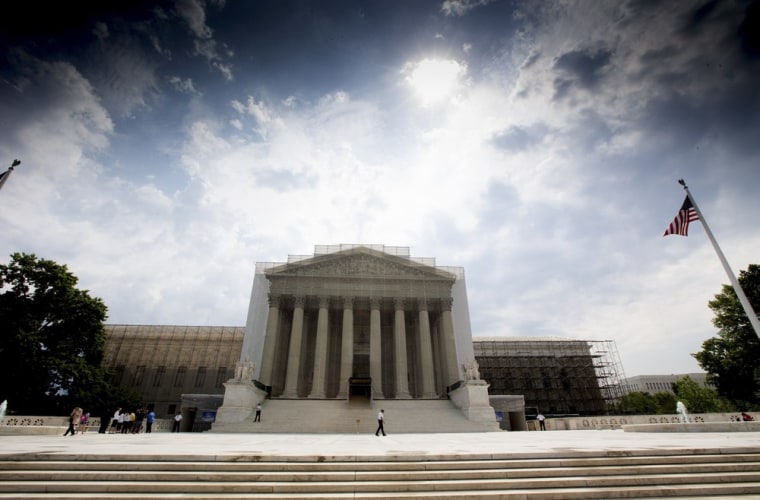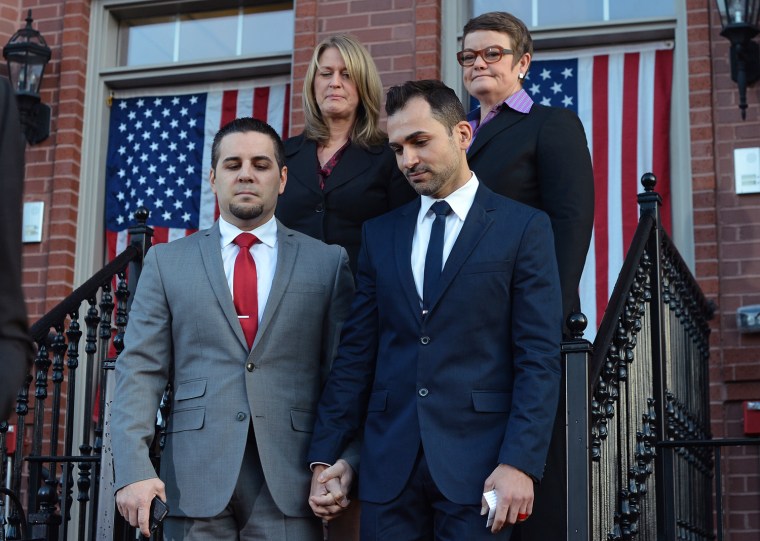
The Supreme Court began to hand down rulings last Monday, and will continue to do so this month, issuing decisions on a variety of hot-button issues -- ranging from the 1965 Voting Rights Act to whether a company can patent a human gene.
It should not be forgotten that at the heart of cases on such controversial issues as DNA testing, same-sex marriage, the federal Defense of Marriage Act and affirmative action in higher education are actual people whose legal challenges have made the long journey to Washington.
Below, a look at some of the citizens who spawned the biggest cases of the Supreme Court's 2013 session:
Case: Same-sex marriage in California/Proposition 8
This case was filed in California in May 2009 on behalf of two same-sex couples who had been denied marriage licenses earlier that month: a lesbian couple, Kris Perry and Sandy Stier, who married in 2004 in San Francisco and had been together for 13 years, raising four sons together from previous relationships; and a gay couple, Paul Katami and Jeff Zarrillo of Burbank, Calif., who had been together for 12 years and once told USA TODAY, "We honestly think of ourselves as kind of regular, everyday guys." Katami and Zarillo wanted to get married and then raise a family together.

The case came to prominence after California's Supreme Court declared it unconstitutional to limit marriage to opposite-sex couples in May 2008. Approximately 18,000 marriage licenses were issued to same-sex couples in the months that followed.
Then, in November 2008, voters in California adopted Proposition 8, an amendment which made "only marriage between a man and a woman" valid in the state.
The case brings together two unlikely courtroom attorneys: Ted Olson and David Boies, who are arguing against the legality of Prop 8. The last time Boies and Olson were together in a courtroom, they represented opposing sides of the 2000 election. Boies worked for Al Gore; Olson is a top conservative litigator.
The two have put their differences aside since then, Olson told The Washington Post last March, calling his work against Prop 8 "the highlight of my life."
"When we win," David Boies told PBS's Charlie Rose in a recent interview, "we'll have eliminated the last bastion of official discrimination."
Case: Taking DNA swabs during arrests
In a 5-4 ruling in its first decision of the term, the Supreme Court on June 3 upheld the police practice of taking DNA samples from people who have been arrested but not convicted of a crime, deciding that the practice is the 21st century-equivalent of fingerprinting. The five justices in the majority wrote that DNA sampling, after an arrest “for a serious offense” and when officers “bring the suspect to the station to be detained in custody,” does not violate the Fourth Amendment’s prohibition of unreasonable searches.
The case arose from the 2009 arrest of a 26-year-old Maryland man named Alonzo King, who was arrested for second-degree assault. Police took a DNA swab from his cheek, ran it through a database, and matched it to an unsolved rape from six years prior. King was convicted of rape and sentenced to life in prison. He pleaded guilty to a misdemeanor for the 2009 assault -- a crime that did not mandate the collection of his DNA (all states collect DNA of convicted felons). The Maryland Court of Appeals later reversed the rape conviction on the grounds that the DNA sample was an unreasonable search.
The Supreme Court decision reverses the Maryland court's ruling and reinstates Alonzo's rape conviction, according to the AP.
Case: The Federal Defense of Marriage Act (DOMA)
Called the United States v. Windsor, this case is named after Edie Windsor, an 83-year-old woman who spent years living with the woman she fell in love with, Thea Spyer.
Spyer had proposed to Windsor in 1967 after the two met in New York in the early 1960s. They couldn't legally marry at the time, but they shared a home and combined their earnings. In 1977, Spyer was diagnosed with multiple sclerosis. Her disease progressed, and she was eventually confined to a wheelchair.
In 2007, when doctors said they expected her to live for only one more year, Spyer again proposed to Windsor, and the two flew to Toronto, where they were officially wed by Canada's first openly gay judge, Justice Harvey Brownstone.
Within a year, their home state of New York officially recognized out-of-state same-sex marriages. The one hold-up was the federal U.S. government. The Federal Defense of Marriage Act, or DOMA, had been signed into law by then-President Bill Clinton in September 1996, and defined marriage as a "legal union between one man and one woman."
DOMA made it impossible for same-sex couples to receive any federal benefits, including those that fall under the tax code.
When Spyer died in February 2009, Windsor was forced to pay hundreds of thousands of dollars in federal estate taxes on the estate Spyer left to her; she would have owed nothing had the government recognized their marriage.
Windsor challenged the estate taxes; the Court of Appeals for the Second Circuit in New York ruled in her favor. The high court ruling will come later this month.
"If it doesn’t happen this time, it will happen next time or the next. But it will happen," Windsor told The New York Times last December.
Case: Affirmative action in school admissions
Abigail Fisher, a white student from Sugar Land, Texas, applied to University of Texas at Austin in 2008. She says she sued after she was rejected, despite meeting criteria for admission — high enough GPA and test scores among them — and African-American students and other minorities with the same scores were admitted to the school.
She was able to bring suit because of a 2003 Supreme Court decision that allowed racial preferences in higher education to increase diversity in public colleges and universities.
Fisher had family members who had gone to UT-Austin, and the school was her top choice, but after she was rejected, she ended up going to Louisiana State University. She has since graduated with a finance degree, and is now 23 years old and is working as a financial analyst, according to Edward Blum, an anti-affirmative action activist who connected Fisher with her lawyers.
Fisher v. University of Texas at Austin is a "landmark" race relations case, according to Tom Goldstein, publisher of the Supreme Court website SCOTUSblog. With its decision, the high court could reaffirm its commitment to affirmative action in higher education admissions, ban affirmative action in admissions, or scale it back.
NBC's Pete Williams and Erin McClam contributed to this report.